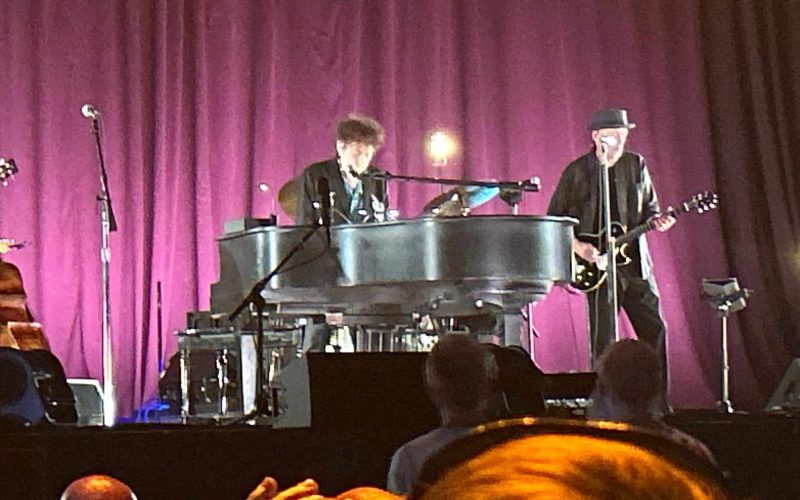Director James Mangold’s Bob Dylan biopic, “A Complete Unknown,” faced several unique challenges in telling an entertaining and mostly factual story about Mr. Dylan. First, the movie is about a legend, one of music’s most iconic performers. Second, the subject in question can be, at times, playful, moody, arrogant, misbehaviorous, deceitful, and humorous.
The movie succeeds due to Mr. Mangold, the actors, a crisp script, and the larger-than-life reality of Dylan’s entry into the folk and rock worlds. The movie may take liberties with some facts, but it never gets trapped in idolizing the folk/rock legend or demonizing him for unfaithful digressions.
Early Dylan Career
The film is based on a book by Elijah Wald: Dylan Goes Electric! covers the period between Dylan’s arrival in New York City in January 1961 and the final day of the 1965 Newport Folk Festival on July 25. It opens with a hitchhiking, Dylan getting a ride into the city. Fresh from leaving Minnesota and his one year at the University, he seeks fame in the folk clubs of Greenwich Village and hopefully a chance to meet his idol, Woody Guthrie.
He meets Guthrie, who can no longer speak because of Huntington’s disease, and he strikes up a friendship with popular folk singer Pete Seeger, who gets him gigs in the Village’s folk clubs, where agent Albert Grossman and John Hammond from Columbia Records discover him. He also met the already famous folksinger Joan Baez that same night.
Hammond signs him to a recording contract but forces him to record only established folk tunes for his debut album. The album sells poorly, and a frustrated Dylan continues to play the clubs, looking for an opportunity to record his music. On the way out the door for a 12-week trip to Europe, his girlfriend Sylvie convinces him to demand that the record company allow him to record his compositions. He is finally able to persuade the brass at Columbia to give him a chance, and the result is the album The Freewheelin’ Bob Dylan with hit anthems like “Blowin’ in the Wind,” “Girl from the North Country,” “Masters of War,” and “A Hard Rain a-Gonna Fall.”
Dylan Makes it Big
Dylan continues to record hit albums and play larger venues, and he is called the “voice of a generation.” However, he starts to resent the label and the expectations thrust on him. He becomes rebellious and moody and continues to spin false yarns about his youth, like his supposed time working in a circus. He also enters into a tumultuous affair with Baez, and they attempt to mix business with pleasure.
When Sylvie returns from Europe, Dylan starts to rebel against the women he feels are too demanding of his time. This comes to a head when Sylvie leaves him and when he and Baez, on tour together, argue on stage over musical differences. His restlessness then leads him to experiment with electronic instruments, which sets the stage for the drama at the Newport Folk Festival in 1965.
Chaos at Newport
Two days before the start of Newport Festival ’65, Dylan releases the electronic single “Like a Rolling Stone.” Panic immediately sets in among festival organizers about whether Bob would play electric at the festival. This was considered blasphemy at the time. On his way down to Newport, he persuades Sylvie to hop on and ride with him down to Rhode Island. There is a circus-like atmosphere when he arrives as Seeger and other festival organizers try to persuade him to perform a traditional acoustic set. Dylan treats them with indifference and refuses to tip his hand.
On the first day of the festival, he joins Baez for a duet on stage, and Sylvie, watching the two of them, realizes that she cannot compete with his entire lifestyle and heads to a boat to take her back to New York. Dylan tries to stop her, but they both know it is over, so she heads back toward the boat and out of his life. The chaos continues, with the festival organizers constantly trying to persuade him to stay true to his folk roots and Grossman and his bandmates egging him on to blow the roof off the place.
The day of the festival arrives, and the final musical decision has yet to be made. Dylan and his bandmates carry both their acoustic and electronic instruments to the stage as the drama builds. Right before he goes on, he sees his pen-pal buddy Johnny Cash and tells him he doesn’t think the audience and the organizers want to hear what he wants to play. To which Cash replies, “I want to hear it.”
Final Scenes
Emboldened, Dylan and his band rip into their first song, “Maggie’s Farm,” tearing up the stage with their electric guitars with the crowd booing and hissing and throwing items at the stage. The mayhem only continues when he closes the set with “It Takes A Lot To Laugh, It Takes A Train To Cry,” and “Like a Rolling Stone.”
There are attempts to shut down Dylan’s set, but eventually, he is allowed to finish the set, and he and his band leave the stage under duress. As an olive branch, Dylan reluctantly returns to the stage to do an acoustic version of “It’s All Over, Baby Blue.” The movie ends with Dylan riding out of the festival area as Seeger looks on wistfully.
More on Dylan
I will also write a second article on “A Complete Unknown” that discusses the actors and characters they play in the movie and the liberties the filmmakers took in producing the film.








